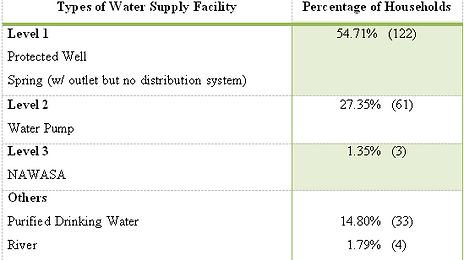

SULONG BACUYONG
environmental health
Water Supply & Sanitation
With the DOH classification of water supply facilities, the following are the percentage distribution among 223 households’ water source for drinking: a) Level 1 facility with 54.71% and may be either from the well or spring b) Level 2 facility with 27.35% and c) Level 3 facility with 1.35%. The remaining percentages of households get their water supply for drinking to either commercial drinking water or directly from the river.
The water source’s distance varies for each purok, in purok 2 the average distance of the water source ranges from 100 to more than 150 meters while for the rest of the Purok the average distance ranges from 50 to 100 meters away from their house.

Based from table 10, 80% of the households do not practice water purification. However, common methods that other households do are boiling that is 10% of the total households followed by filtration and chlorination with 4% and 3% respectively. Identifying households practicing water purification can determine as to whom family is susceptible to preventable diseases. Based from the survey, most of the households do not practice any method. It can cause morbidity among children if water for drinking came directly to an unsafe water source.



Waste disposal
Garbage segregation has been a practice being promoted nationwide by separating biodegradable waste from non-biodegradable waste. The barangay had been adapting segregation for quite a long time by having 2 types of pit in their household for garbage disposal. However, there is no collection system in the municipality for the non-biodegradable waste for each barangay. Thus, the non-biodegradable wastes are left in the compost/ burial pit.